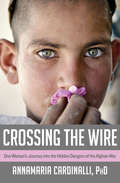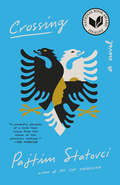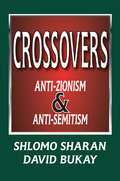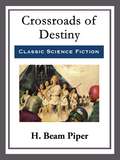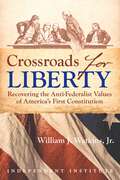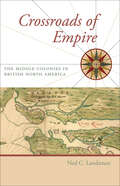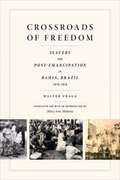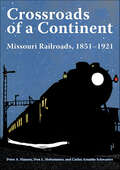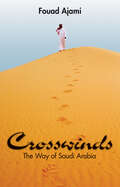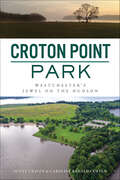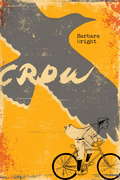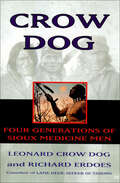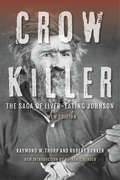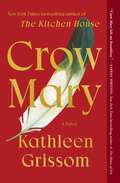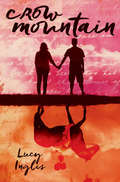- Table View
- List View
Crossing the Threshold of Hope
by Vittorio Messori Pope John Paul IIA great international bestseller, the book in which, on the eve of the millennium, Pope John Paul II brings to an accessible level the profoundest theological concerns of our lives. He goes to the heart of his personal beliefs and speaks with passion about the existence of God; about the dignity of man; about pain, suffering, and evil; about eternal life and the meaning of salvation; about hope; about the relationship of Christianity to other faiths and that of Catholicism to other branches of the Christian faith. With the humility and generosity of spirit for which he is known, John Paul II speaks directly and forthrightly to all people. His message: Be not afraid!
Crossing the Tracks
by Barbara StuberAt fifteen, Iris is a hobo of sorts -- no home, no family, no direction. After her mother's early death, Iris's father focuses on big plans for his new shoe stores and his latest girlfriend, and has no time for his daughter. Unbeknownst to her, he hires Iris out as housekeeper and companion for a country doctor's elderly mother. Suddenly Iris is alone, stuck in gritty rural Missouri, too far from her only friend Leroy and too close to a tenant farmer, Cecil Deets, who menaces the neighbors and, Iris suspects, his own daughter. Iris is buoyed by the warmth and understanding the doctor and his mother show her, but just as she starts to break out of her shell, tragedy strikes. Iris must find the guts and cunning to take aim at the devil incarnate and discover if she is really as helpless--or as hopeless--as she once believed. Lyrical, yet humorous, Barbara Stuber's debut novel is the unforgettable story of a girl who struggles to cast aside her long-standing grief and doubt and, in the span of one dusty summer, learn to trust, hope, and--ultimately--love.
Crossing the Wire: One Woman's Journey into the Hidden Dangers of the Afghan War
by AnnaMaria CardinalliIn a harrowing memoir, the military journalist discusses her explosive report on sexual practices in Afghanistan and her experience in the War on Terror. When AnnaMaria Cardinalli&’s explosive United States military report on the topic of sexuality in southern Afghanistan was leaked to mainstream American media, it generated a firestorm of attention and reaction. While some of the findings regarding Afghan sexual practices are simply of cultural interest, other findings raise grave humanitarian issues, such as the cyclical abuse of young boys, perpetuated over countless generations. In Crossing the Wire, Cardinalli invites readers to share her rare experiences working on the farthest front of the War on Terror as a female member of one of the Pentagon&’s Human Terrain System teams in the Pashtun-inhabited southern region. Cardinalli opens an intimate window into the fascinating and almost surreal difficulty of our military&’s job in that country, and the indispensable place of a woman&’s hand in the world of war.From women&’s rights to Afghanistan&’s economic development and security to the recruitment for and development of terrorism worldwide, Afghan sexuality has profound and disturbing consequences on many aspects of life. Cultural sexism is not simply the province of Central Asians; it&’s also present in our own politico-military culture. This book goes far beneath the headlines of our seemingly endless war in Afghanistan to inform us of the exact situation with the opposition, in more important ways than one. It is a must-read for every citizen concerned with our—or the Afghan people&’s—progress henceforth in that region.
Crossing the Wire: The untold stories of Australian POWs in battle an captivity during WWI (Big Sky Publishing Ser.)
by David Coombes"Truly we are objects of interest to the Jerries we meet on the road, and especially in the villages. Taunts are hurled at us; epithets are numerous, and souvenir hunters molest us, but so far not violently. After passing through the village of Villers, we come across some British prisoners who are clearing the road, and they present a sorry spectacle, unshaven and dirty looking... Some offered some appeal for food, but we have none to give. In fact we are ourselves hungry... Their predicament does not create in us a very favourable impression, although I like others, do not realise the seriousness of what is in store for us. The future is a blank, as no-one knows what it holds." So wrote an Australian prisoner-of-war, Corporal Lancelot Davies, only recently taken prisoner at the first battle of Bullecourt, on 11 April 1917. For him - like another 1,200 Australians captured at Bullecourt - the future was indeed `blank' and unpredictable. The experiences of Australian prisoners of war (POWs) or Kriegsgefangeners held captive in Germany has been largely forgotten or ignored- overshadowed by the terrible stories of Australians imprisoned by the Japanese during World War II. Yet, as David Coombes makes known, the stories are interesting and significant - not only providing an account of what those young Australian soldiers experienced, and the spirit they showed in responding to captivity - but also for the insight it provides into Germany in the last eighteen months of the war. Drawing on previous inaccessible records, Coombes focuses on one Australian brigade, the 4th Infantry, from its formation in 1914, through Gallipoli to its baptism of fire on the Western Front, culminating in the first battle of Bullecourt - which, in turn, leads to the prisoner of war experience.
Crossing: A Novel
by Pajtim StatovciFrom the acclaimed author of My Cat Yugoslavia: a stunning, incandescent new novel that speaks to identity, war, exile, love, betrayal, and heartbreakThe death of head of state Enver Hoxha and the loss of his father leave Bujar growing up in the ruins of Communist Albania and of his own family. Only his fearless best friend, Agim—who is facing his own realizations about his gender and sexuality—gives him hope for the future. Together the two decide to leave everything behind and try their luck in Italy. But the struggle to feel at home—in a foreign country and even in one's own body—will have corrosive effects, spurring a dangerous search for new identities.Steeped in a rich heritage of bewitching Albanian myth and legend, this is a deeply timely and deeply necessary novel about the broken reality for millions worldwide, about identity in all its complex permutations, and the human need to be seen.
Crossovers: Anti-zionism and Anti-semitism
by Shlomo SharanCrossovers compares Jewish anti-Zionism and Palestinian anti-Semitism from political and philosophical points of view. The authors' goal is to expose what is unique about these phenomena, and what they share, so that both ideologies and their practical impact can be better understood.The authors identify a symbiotic relationship between anti-Semitic Palestinian doctrines and those Jews who are anti-Zionists. There has been a great deal of research on these as separate phenomena, but there has thus far been no research that has noted their similarities. Palestinian anti- Semitism and Jewish anti-Zionism may stem from different sources, but they have similar consequences. Palestinian views derive from religious Islamic as well as nationalist- Arab roots, while the views of anti-Zionist Jews grew out of an ideological-Marxist-Trotskyite background. But both share a common goal: the destruction of the Jewish-Zionist nation, and a common strategy, to achieve a bi-national state as a first stage in the march to this goal.Jewish history is replete with examples of how Jews have ignored repeated threats and acts of violence against them. That characteristic of Jews reflects their Messianic belief, but it lacks a basis in history. That belief has resisted change even in the face of threats that were obvious and that have endangered Jewish lives in the past. Contemporary anti-Zionists share this optimistic outlook. Paradoxically, while the Jewish-Zionist State of Israel contends in public that another Holocaust will not happen and is patently impossible, the lesson of recent Jewish history is that a Holocaust can happen again. This work is unrelenting in its criticisms and tough minded in its assessments of the future. It merits careful, serious reading.
Crossroad's of Destiny
by H. Beam PiperReaders who remember the Hon. Stephen Silk, diplomat extraordinary, in Lone Star Planet (FU, March 1957), later published as A Planet For Texans (Ace Books), will find the present story a challenging departure--this possibility that the history we know may not be absolute . . . .
Crossroads (Welcome to Tyler)
by Marisa CarrollWELCOME TO TYLER-CAN YOU BELIEVE THE NEWS?Something odd is going on at Worthington House. Several of the elderly residents have died—but is it of natural causes? Questions multiply as an investigation of these baffling events engrosses America's favorite hometown.AN OLD FLAME REKINDLEDDoctor Jeffrey Baron had been nurse Cecelia Hayes's first love. Now they are thrown together again when the recently widowed Cece returns to Tyler after a ten-year absence.AGAINST A BACKDROP OF DANGERJeff and Cece had both been hurt when they parted years ago. But as they work together to determine what's killing the residents of Worthington House, they find themselves drawn to each other…Previously Published.
Crossroads at Clarksdale
by Françoise N. HamlinWeaving national narratives from stories of the daily lives and familiar places of local residents, Francoise Hamlin chronicles the slow struggle for black freedom through the history of Clarksdale, Mississippi. Hamlin paints a full picture of the town over fifty years, recognizing the accomplishments of its diverse African American community and strong NAACP branch, and examining the extreme brutality of entrenched power there. The Clarksdale story defies triumphant narratives of dramatic change, and presents instead a layered, contentious, untidy, and often disappointingly unresolved civil rights movement.Following the black freedom struggle in Clarksdale from World War II through the first decade of the twenty-first century allows Hamlin to tell multiple, interwoven stories about the town's people, their choices, and the extent of political change. She shows how members of civil rights organizations--especially local leaders Vera Pigee and Aaron Henry--worked to challenge Jim Crow through fights against inequality, police brutality, segregation, and, later, economic injustice. With Clarksdale still at a crossroads today, Hamlin explores how to evaluate success when poverty and inequality persist.
Crossroads for Liberty: Recovering the Anti-Federalist Values of America's First Constitution
by William J. Watkins Jr.What did the American Founders actually intend for the country, and does it even matter today? If America began as an idea, then what kind of idea?In a time of increasing turmoil over American history, politics, and society, Crossroads for Liberty: Recovering the Anti-Federalist Values of America&’s First Constitution takes a surprising and thought-provoking look at the American Revolution, the Articles of Confederation, and the Constitution, and asks what we can learn from them. Author William Watkins casts a critical eye on conventional wisdom about the Articles of Confederation, as he outlines the differences between that original U.S. governing document and the Constitution, which replaced it. He finds that the Articles protected individual liberty and community-centered government in ways that the looser language of the U.S. Constitution did not. Watkins draws from contemporary examples of bureaucratic overreach and expansion to support his argument—examples that were startlingly predicted by proponents of small government at the time of the Constitution&’s adoption. Along the way, he points back to the Articles and the values of the American Revolution as a framework for reimagining American politics to foster liberty and truly representative governance. Crossroads for Liberty arrives at an important time in American political life, and its reexamination of the American Founding presents a significant contribution to the story about America. Readers will come away with a greater understanding of current political and constitutional issues, as well as a new perspective on American history.
Crossroads of Empire: The Middle Colonies in British North America (Regional Perspectives on Early America)
by Ned C. LandsmanThis work examines the Middle Colonies—New York, New Jersey, and Pennsylvania—as a region at the center of imperial contests among competing European powers and Native American nations and at the fulcrum of an emerging British-Atlantic world of culture and trade.Ned C. Landsman traces the history of the Middle Colonies to address questions essential to understanding their role in the colonial era. He probes the concept of regionality and argues that while each territory possessed varying social, religious, and political cultures, the collective lands of New York, New Jersey, and Pennsylvania came to function as a region because of their particular history and their distinct place in the imperial and Atlantic worlds. Landsman demonstrates that the societal cohesiveness of the three colonies originated in the commercial and military rivalries among Native nations and developed further with the competing involvement of the European powers, eventually emerging as the focal point in the contest for dominion over North America. In relating this progression, Landsman discusses various factors in the region's development, including the Enlightenment, evangelical religion, factional politics, religious and ethnic diversity, and distinct systems of Protestant pluralism. Ultimately, he argues, it was within the Middle Colonies that the question was first posed, What is the American?An insightful and valuable classroom synthesis of the scholarship of the Middle Colonies, Crossroads of Empire makes clear the vital role of New York, New Jersey, and Pennsylvania in establishing an American identity.
Crossroads of Empire: The Middle Colonies in British North America (Regional Perspectives on Early America)
by Ned C. LandsmanThis work examines colonial New York, New Jersey, and Pennsylvania as central to both warfare and the emerging British-Atlantic world of culture and trade.In this probing history, Ned C. Landsman demonstrates how the Middle Colonies came to function as a distinct region. He argues that while each territory possessed varying social, religious, and political cultures, the collective lands of New York, New Jersey, and Pennsylvania were unified in their particular history and place in the imperial and Atlantic worlds. Landsman shows that the societal cohesiveness of the three colonies originated in the commercial and military rivalries among Native nations and developed further with the competing involvement of the European powers. They eventually emerged as the focal point in the contest for dominion over North America. In relating this progression, Landsman discusses various factors in the region’s development, including the Enlightenment, evangelical religion, factional politics, religious and ethnic diversity, and distinct systems of Protestant pluralism. Ultimately, he argues, it was within the Middle Colonies that the question was first posed, What is the American?
Crossroads of Freedom: Antietam (Pivotal Moments in American History)
by James M. McphersonPivotal moments during the CivilWar.
Crossroads of Freedom: Slaves and Freed People in Bahia, Brazil, 1870-1910
by Walter Fraga Mary Ann MahonyBy 1870 the sugar plantations of the Recôncavo region in Bahia, Brazil, held at least seventy thousand slaves, making it one of the largest and most enduring slave societies in the Americas. In this new translation of Crossroads of Freedom--which won the 2011 Clarence H. Haring Prize for the Most Outstanding Book on Latin American History--Walter Fraga charts these slaves' daily lives and recounts their struggle to make a future for themselves following slavery's abolition in 1888. Through painstaking archival research, he illuminates the hopes, difficulties, opportunities, and setbacks of ex-slaves and plantation owners alike as they adjusted to their postabolition environment. Breaking new ground in Brazilian historiography, Fraga does not see an abrupt shift with slavery's abolition; rather, he describes a period of continuous change in which the strategies, customs, and identities that slaves built under slavery allowed them to navigate their newfound freedom. Fraga's analysis of how Recôncavo's residents came to define freedom and slavery more accurately describes this seminal period in Brazilian history, while clarifying how slavery and freedom are understood in the present.
Crossroads of Ravens: A brand-new Witcher novel starring Geralt of Rivia – Now a major Netflix show (The Witcher #9)
by Andrzej SapkowskiWitchers are not born. They are made.Before he was the White Wolf or the Butcher of Blaviken, Geralt of Rivia was simply a fresh graduate of Kaer Morhen, stepping into a world that neither understands nor welcomes his kind.And when an act of naïve heroism goes gravely wrong, Geralt is only saved from the noose by Preston Holt, a grizzled witcher with a buried past and an agenda of his own.Under Holt's guiding hand, Geralt begins to learn what it truly means to walk the Path - to protect a world that fears him, and to survive in it on his own terms. But as the line between right and wrong begins to blur, Geralt must decide to become the monster everyone expects, or something else entirely.This is the story of how legends are made - and what they cost.Andrzej Sapkowski's Witcher series is a global phenomenon with over thirty million copies sold, translated into over forty languages worldwide. Crossroads of Ravens is a new standalone novel following fantasy's most beloved monster hunter, Geralt of Rivia, on his first steps towards becoming a legend.Translated from original Polish by David French
Crossroads of a Continent: Missouri Railroads, 1851–1921 (Railroads Past and Present)
by Don L. Hofsommer Carlos Arnaldo Schwantes Peter A. HansenCrossroads of a Continent: Missouri Railroads, 1851-1921 tells the story of the state's railroads and their vital role in American history. Missouri and St. Louis, its largest city, are strategically located within the American Heartland. On July 4, 1851, when the Pacific Railroad of Missouri began construction in St. Louis, the city took its first step to becoming a major hub for railroads. By the 1920s, the state was crisscrossed with railways reaching toward all points of the compass.Authors Peter A. Hansen, Don L. Hofsommer, and Carlos Arnaldo Schwantes explore the history of Missouri railroads through personal, absorbing tales of the cutthroat competition between cities and between railroads that meant the difference between prosperity and obscurity, the ambitions and dreams of visionaries Fred Harvey and Arthur Stilwell, and the country's excitement over the St. Louis World's Fair of 1904.Beautifully illustrated with over 100 color images of historical railway ephemera, Crossroads of a Continent is an engaging history of key American railroads and of Missouri's critical contribution to the American story.
Crosswinds: The Way of Saudi Arabia
by Fouad AjamiFouad Ajami presents a firsthand look at the political culture in Saudi Arabia and its conduct and influence in foreign lands from the early 1990s to around 2010. From the influence of Islam in public life to Saudi rulers' attitudes toward the George W. Bush and Obama administrations, the author fills a significant gap in our understanding of that country.
Croton Point Park: Westchester's Jewel on the Hudson (Landmarks)
by Scott Craven Caroline Ranald CurvanLess than an hour by train from New York City...Croton Point Park encapsulates the history, beauty and promise of the Hudson Valley. The Westchester County Park encompasses miles of Hudson River shoreline with astonishing views and remnants of the region's past. Incredible shell mounds shed light on the Native peoples who inhabited the area generations prior to European colonization. The remains of the first commercial vineyards in the Northeast are just steps away from historic brickyards that helped build Manhattan. The Point served as a dumping ground for years until local efforts restored the park into a model of environmental conservation. Today, bald eagles have returned to nest alongside visitors exploring remarkable landmarks, sailing the waters of the Hudson or enjoying a scenic picnic. Authors Scott Craven and Caroline Ranald Curvan present Westchester's crown jewel, Croton Point Park.
Crow
by Barbara WrightThe summer of 1898 is filled with ups and downs for 11-year-old Moses. He's growing apart from his best friend, his superstitious Boo-Nanny butts heads constantly with his pragmatic, educated father, and his mother is reeling from the discovery of a family secret. Yet there are good times, too. He's teaching his grandmother how to read. For the first time she's sharing stories about her life as a slave. And his father and his friends are finally getting the respect and positions of power they've earned in the Wilmington, North Carolina, community. But not everyone is happy with the political changes at play and some will do anything, including a violent plot against the government, to maintain the status quo.One generation away from slavery, a thriving African American community--enfranchised and emancipated--suddenly and violently loses its freedom in turn of the century North Carolina when a group of local politicians stages the only successful coup d'etat in US history.From the Hardcover edition.
Crow Call
by Lois LowryThe story of young Liz and her father, who has been away at WWII for longer than she can remember. They begin their journey of reconnection through a hunting shirt, cherry pie, tender conversation, and the crow call. This allegorical story shows how, like the birds gathering above, the relationship between the girl and her father is graced with the chance to fly.
Crow Call (Junior Great Books Series 3)
by Lois LowryThe two-time Newbery medalist has crafted “a loving representation of a relationship between parent and child” in post-WWII America (Publishers Weekly, starred review).This is the story of young Liz, her father, and their strained relationship. Dad has been away at WWII for longer than she can remember, and they begin their journey of reconnection through a hunting shirt, cherry pie, tender conversation, and the crow call. This allegorical story shows how, like the birds gathering above, the relationship between the girl and her father is graced with the chance to fly.“The memory of a treasured day spent with a special person will resonate with readers everywhere.” —School Library Journal (starred review)“Beautifully written, the piece reads much like a traditional short story . . . the details of [Ibatoulline’s] renderings gracefully capture a moment in time that was lost. Relevant for families whose parents are returning from war, the text is also ripe for classroom discussion and for advanced readers.” —Kirkus Reviews
Crow Dog: Four Generations of Sioux Medicine Men
by Richard Erdoes Leonard C. Dog“Through the experiences of this family of great medicine men, readers are taken on an intimate journey through 120 years of Lakota history.” —Library Journal“I am Crow Dog. I am the fourth of that name. Crow Dogs have played a big part in the history of our tribe and in the history of all the Indian nations of the Great Plains during the last two hundred years. We are still making history.”Thus opens the extraordinary and epic account of a Native American clan. Here the authors, Leonard Crow Dog and Richard Erdoes (coauthor of Lakota Woman) tell a story that spans four generations and sweeps across two centuries of reckless deeds and heroic lives, and of degradation and survival.The first Crow Dog, Jerome, a contemporary of Sitting Bull and Crazy Horse, was a witness to the coming of white soldiers and settlers to the open Great Plains. His son, John Crow Dog, traveled with Buffalo Bill Cody’s Wild West Show. The third Crow Dog, Henry, helped introduce the peyote cult to the Sioux. And in the sixties and seventies, Crow Dog’s principal narrator, Leonard Crow Dog, took up the family’s political challenge through his involvement with the American Indian Movement (AIM). As a wichasha wakan, or medicine man, Leonard became AIM’s spiritual leader and renewed the banned ghost dance. Staunchly traditional, Leonard offers a rare glimpse of Lakota spiritual practices, describing the sun dance and many other rituals that are still central to Sioux life and culture. “An illuminating introduction to Sioux culture.” —Publishers Weekly
Crow Killer, New Edition
by Robert Bunker Raymond W. Thorp Jr.The movie Jeremiah Johnson introduced millions to the legendary mountain man, John Johnson. The real Johnson was a far cry from the Redford version. Standing 6'2" in his stocking feet and weighing nearly 250 pounds, he was a mountain man among mountain men, one of the toughest customers on the western frontier. As the story goes, one morning in 1847 Johnson returned to his Rocky Mountain trapper's cabin to find the remains of his murdered Indian wife and her unborn child. He vowed vengeance against an entire Indian tribe. Crow Killer tells of that one-man, decades-long war to avenge his beloved. Whether seen as a realistic glimpse of a long ago, fierce frontier world, or as a mythic retelling of the many tales spun around and by Johnson, Crow Killer is unforgettable. This new edition, redesigned for the first time, features an introduction by western frontier expert Nathan E. Bender and a glossary of Indian tribes.
Crow Mary: A Novel
by Kathleen GrissomThe New York Times bestselling author of the book club classics The Kitchen House and Glory Over Everything returns with a sweeping and &“richly detailed story of a woman caught between two cultures&” (Sandra Dallas, New York Times bestselling author) inspired by the real life of Crow Mary—an Indigenous woman in 19th-century North America.In 1872, sixteen-year-old Goes First, a Crow Native woman, marries Abe Farwell, a white fur trader. He gives her the name Mary, and they set off on the long trip to his trading post in Saskatchewan, Canada. Along the way, she finds a fast friend in a Métis named Jeannie; makes a lifelong enemy in a wolfer named Stiller; and despite learning a dark secret of Farwell&’s past, falls in love with her husband. The winter trading season passes peacefully. Then, on the eve of their return to Montana, a group of drunken whiskey traders slaughters forty Nakota—despite Farwell&’s efforts to stop them. Mary, hiding from the hail of bullets, sees the murderers, including Stiller, take five Nakota women back to their fort. She begs Farwell to save them, and when he refuses, Mary takes two guns, creeps into the fort, and saves the women from certain death. Thus, she sets off a whirlwind of colliding cultures that brings out the worst and best in the cast of unforgettable characters and pushes the love between Farwell and Crow Mary to the breaking point. From &“a tremendously gifted storyteller&” (Jim Fergus, author of The Vengeance of Mothers), Crow Mary is a &“tender, compelling, and profoundly educational and satisfying read&” (Sadeqa Johnson, author of The Yellow Wife) that sweeps across decades, showcasing the beauty of the natural world, while at the same time probing the intimacies of a marriage and one woman&’s heart.
Crow Mountain (Chicken House Novels Ser.)
by Lucy InglisA sweeping tale of love, legacy, and wilderness set between the present day and 1867 in the dramatic landscape of modern-day and territorial Montana.While on a trip to Montana with her mom, British teen Hope meets local boy Cal Crow, a ranch hand. Caught in a freak accident, Hope and Cal take shelter in a cabin, where Hope makes a strange discovery in an abandoned diary. More than a hundred years earlier, another British girl--Emily--met a similar fate. Her rescuer, a horse trader named Nate. In this rugged place, both girls learn what it means to survive and to fall in love, neither knowing that their fates are intimately entwined.


